- October 30, 2024
-
-
Loading

Loading

On a blustery day in late March, Bill Samuels surveys the vast, flat expanse of trees and bushes and grasslands of Duette Preserve in northeastern Manatee County. A slight smile purses his lips. He is clad in his uniform of camo pants, boots, green brimmed hat and a golf shirt with “Florida Panther Project” stitched in script on the chest. The only sound is the wind rustling the trees. Wispy clouds share the sky with brilliant sunshine. The location is significant because about a football field away a male panther had been caught on video by a hunter’s trail camera. The sighting was a big deal. It even made the nightly news.
Samuels is elated to be standing on the same ground that a Florida panther had recently trod. He has devoted much of his adult life to the preservation of the endangered feline and to raising awareness of the elusive animal. At age 69, he continues to share his encyclopedic knowledge and folksy charm in slideshow presentations at libraries and community centers. “We’re as low-tech as it comes,” he says with a chuckle. “And it works. It works.”
Samuels is also elated by a February court ruling that prevents the state of Florida from issuing permits to disturb wetlands. The policy, in effect since 2020, essentially allowed an end run of the federal Endangered Species Act. According to Earthjustice, one of the environmental groups that brought suit, the ruling halts two large developments that would have destroyed thousands of acres of panther habitat. “The Florida panther is one of the few things that we think can actually stop bulldozers,” Samuels says. “The wood storks and bald eagles and black bears and all of the other endangered species will be helped by every acre set aside for the panther.”
Panther sightings are rare in Manatee County — about six documented ones in the last 18 months — but are becoming less so. The cats have been forced to migrate farther north as southwestern Florida becomes less hospitable. It was just eight years ago that for the first time in four decades a female panther was seen north of the Caloosahatchee River in Fort Myers — long considered the northern limit of panther country.
They are solitary animals. A male may carve out turf as much as 200 square miles. Young males are not welcome and may be killed for trespassing. That forces the younger ones to stake out their own territory. And suitable habitats are becoming harder to come by.
We were standing in one such enclave on that lovely day in March. Duette Preserve, at 22,000 acres the largest land preserve in the county, is a top-level panther habitat. One of the park’s rangers, Jerry Miller — whose truck led our small caravan into the park — has been fortunate enough to see a panther in the Duette tract. “I was in a grove on the border of the preserve, and he was under an orange tree, just layin’ there,” Miller recounted. “I got pretty close to him, got a video and pictures. He just laid there until I got a little too close and he just kinda walked away. It was probably the coolest thing I’ll ever see in my life.”
That magical moment could have never happened 20 miles west, near Parrish, where traffic is ever increasing. Sheets of dust whip across Wauchula Road like a scene from “Dune” — but with trucks.

The biggest threat to Florida panthers is the motor vehicle. According to the Florida Fish and Wildlife Conservation Commission (FWC), 47 confirmed panther deaths occurred from the beginning of 2022 until March 21 of this year. Forty-four were attributed to vehicles. As the cats roam farther and farther looking for territory, they’re forced to traverse roads, often major highways with increasing traffic.
The U.S. Fish and Wildlife Service estimates that between 120 and 230 panthers live in the wild in Florida. That’s up considerably from 1973, the first year of the Endangered Species Act, when the Florida panther — the only remaining big cat in the eastern U.S. — was placed on the first endangered list. “Florida officials were kind of embarrassed because they really didn’t know if [the state] had any panthers left,” Samuels explains. So, a coalition of government agencies enlisted an expert from Texas who brought in cougar-hunting dogs and determined that, yes, there were some panthers remaining.
For years, the population hovered around 30, veering toward possible extinction, with some cats suffering from genetic defects due to inbreeding. In 1995, wildlife officials imported eight female cougars from Texas to mate with males. (Panthers, cougars, pumas and mountain lions are all the same breed.) The project was a success, and the panther population rebounded. “Female cougars,” Samuels muses, smiling. “We get a lot of jokes about that.”

Samuels gives government protection policies an A+ grade but advocates for human-assisted relocation of panthers to northern Florida. “There have been studies done that have produced overwhelming evidence that there are areas of north Florida that could easily support panthers,” he says. “They could even move into Georgia and up into the Appalachians. But politically, the will to do it is not there yet.”
Why the pushback from north Florida? Samuels cites the cat’s protected status as potentially curtailing development; avid hunters fearing that the panthers will decimate the deer population and, less so, an ongoing fear of panthers as large predators.
Samuels doesn’t expect a relocation program to start any time soon but likes what he sees in terms of public sentiment. “The people’s love for the panther has increased exponentially,” he says.
Bill Samuels didn’t start out a panther guy. He grew up in Silver Spring, Maryland, just north of Washington, D.C., a typical suburban kid with a paper route and a worn baseball mitt. His uncle owned land near Winchester, Virginia, about 90 miles west of home. “We used to go up there, and I became an outdoors type of guy, fishing and hunting and all that stuff,” he says.
In 1969, when Samuels was 15, his family moved to Titusville, Florida, where his father, Ken, an engineer and former Marine, worked on the Apollo 11 lunar landing. “He was one of about 20 people working shoulder to shoulder with Neil Armstrong, Buzz Aldrin and Michael Collins,” Samuels says, referring to the astronauts on that historic mission. “If it sounds like I’m proud of him, it’s because I am. He set the bar pretty high for me.”

The family moved back north to Newport News, Virginia, where Samuels graduated high school. He attended Montgomery College in Rockville, Maryland, for a couple of years, where “I studied playing baseball,” he quips. A pitcher, he suffered an elbow injury, which ended his college career. Samuels met his wife of 48 years, Connie, at a high school basketball game. “After a while, we decided we wanted to come back down [to Florida],” Samuels says. “We’ve been here full time since 1985.”
The transplanted outdoorsman became a volunteer with the FWC, doing wildlife identification classes. That sparked his interest in the Florida panther, and he soon homed in on the species as the one he most wanted to champion. “I got to understand that there are panthers in Florida and there may not be any in the future,” he says. Samuels filed paperwork for the Florida Panther Project to become a 501(c)(3) nonprofit. (As founder and president, he never paid himself or his family a penny for their efforts.)
“I thought, ‘Oh, boy, here we go. We’re gonna save the panther, save the land, gonna really get people behind this,’” he recalls. “Then reality set in pretty quick.”
In 1994, Samuels attended a hearing on the big cat’s future held by the Florida Panther Interagency Task Force. At the time, it was thought there were as few as 20 remaining in the wild. The meeting in the Lee County courthouse turned hostile as ranchers, farmers, environmentalists and bureaucrats clashed. “The Task Force basically said, ‘Here’s what we’re gonna do to save the panther. And, by the way, we’re doin’ it on y’all’s property,’” Samuels says. “It was a public relations disaster for the government people.”
Samuels, who understood both sides of the argument, left the meeting thinking, “I have a lot to learn about the recovery of the Florida panther and the politics behind it.”
He engaged in extensive research — all while he and Connie raised six kids in a home just south of Lakewood Ranch, and Samuels worked as a contractor doing home renovations and painting. Along with volunteers, including most of his family, Samuels traveled the state putting on presentations. He’d often bring along panthers borrowed from friends. “We’d advertise a live panther and would have to put up crowd-control devices,” he says. “We’d do fairs and a lot of schools. The kids were spellbound.”
In the early 2000s, new insurance rules caused schools and community centers to shy away from exhibiting live panthers, so the Florida Panther Project went the slideshow route. Samuels’ presentations, about an hourlong followed by a Q&A, are not pro-environment rants or anti-development polemics. Rather, they’re relaxed, informal narratives about the cat — its history, its remarkable survival, its ongoing plight, its future prospects. The shows are meant to instill in audiences an admiration for Florida’s state animal and encourage attendees to fully embrace the idea that they must be protected.

Even the most diehard panther lover is unlikely to ever see one in its native habitat. (Samuels says that in Florida there are far more panthers in captivity than ones out in the field.) It happened for Samuels in 2018. He and Connie went down to Picayune Strand State Forest east of Naples to look into a “suspicious panther death,” when they saw two yearling cats cross the main entrance road about a half-hour before dark. Their sighting went undocumented. “We couldn’t get to a camera quick enough,” he says with a wry chuckle. “We thought the mother might come along, but she never did.”
Samuels doesn’t fret about the panther’s imminent extinction, but he still worries. “The roadkill numbers are concerning,” he said. “They could indicate that the population is starting to decrease.”
One recent trend fortifies his hope. “I’ve never been more optimistic about land conservation efforts in the state,” he says. “We’re seeing tremendous purchases of huge amounts of land by the government and nonprofits. The will of the people to preserve land has never been better.”
Which bodes well for the Florida panther’s ongoing survival.